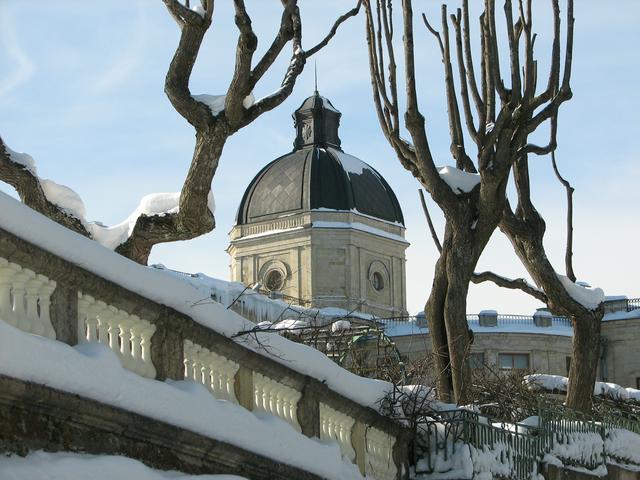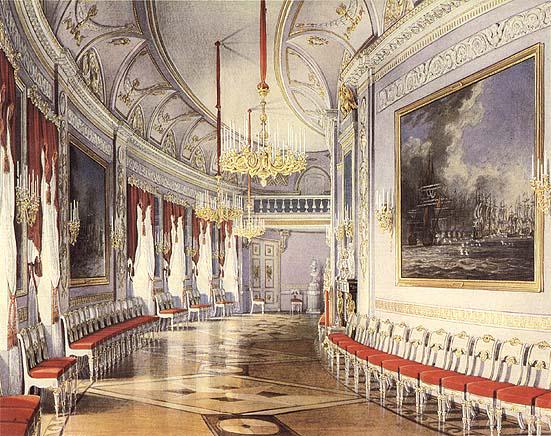Gatchina is located in Leningrad Oblast. It is the biggest city in it and also the center of Gatchinsky District. Its population is 92815 (2010 info).

-TVSbK.medium.jpg)

- Gatchina Palace, 1, Krasnoarmeysky prospekt, +7 812 958 0366. 10h-18h, closes Mon. Major imperial residence, was begun in 1766–1781 by architect Antonio Rinaldi for Count Grigori Grigoryevich Orlov, favourite of Catherine II. She took such a great liking of the Gatchina Palace and park, that at Orlov's death in 1783, she bought it from his heirs and presented it to her son, the future Emperor Paul I, who went to live there for 18 years. He invested considerable resources and used his experience from his travels around Europe to make Gatchina an exemplary palace and town. During the 1790s, Paul expanded and rebuilt much of the palace, and renovated interiors in Neoclassical style. Paul I graced the park with bridges, gates, pavilions, "The Isle of Love", "The Private Garden" and "The Labyrinth" among many other additions. In 1796, after the death of his mother, Catherine the Great, Paul became Emperor Paul I of Russia, and granted Gatchina the status of Imperial City .
After Paul's death the grand palace and park were owned by his widow, Maria Feodorovna, from 1801 to 1828 and after her by their son, Nicholas I, master from 1828 to 1855. He made the most significant expansion of the palaces and parks, adding the Arsenal Halls to the main palace. The Arsenal Halls served as the summer residence of the emperor. In 1851, Nicholas I erected a monument to his father, Paul I, in front of the Palace. In 1854 the railroad between St. Petersburg and Gatchina was opened. At that time the city of Gatchina's territory was expanded by incorporation of several villages and vicinity.
Alexander II used Gatchina Palace as his second residence. He built a hunting village, and turned the area south of Gatchina into a retreat where the Emperor and his guests could indulge in living in the unspoiled wilderness. Alexander II also made updates and renovations in the main Gatchina Palace.
Alexander III made Gatchina his primary residence, after witnessing the shock and stress of his father's assassination, in a terrorist bomb attack. Gatchina became known as 'The Citadel of Autocracy' after his reactionary stance. He and his family lived most of his time in Gatchina Palace. Here he signed decrees, held diplomatic receptions, theatrical performances, masquerades and costumed balls, and other events and entertainment. Alexander III introduced technological modernizations in the Gatchina Palace and parks such as electric lights, a telephone network, non-freezing water pipes and a modern sewage system.
His son Nicholas II, the last Russian tsar, spent his chidhood and youth in the Gatchina Palace. His mother, Empress Maria Feodorovna, widow of Alexander III, was the patron of the city of Gatchina and Gatchina Palace and parks, and lived here until 1917.
After the Revolution of 1917, the Gatchina Palace was turned into a museum, opened to public on 19 May 1918. The late 18th-century state and private rooms were accessible to visitors, in the main building and the galleries, with all rooms of historical and artistic value displayed. The Arsenal Block housed a museum of palatial furnishings and household utilities of the late 19th century. The rooms which did not retain their original integrity were used for displays of pieces borrowed from the abundant palace stocks. The palace was badly damaged during the 1941-1945 war; the decor suffered most of all. Restoration work is still in progress. adults, students.
Gatchina Palace, 1, Krasnoarmeysky prospekt, +7 812 958 0366. 10h-18h, closes Mon. Major imperial residence, was begun in 1766–1781 by architect Antonio Rinaldi for Count Grigori Grigoryevich Orlov, favourite of Catherine II. She took such a great liking of the Gatchina Palace and park, that at Orlov's death in 1783, she bought it from his heirs and presented it to her son, the future Emperor Paul I, who went to live there for 18 years. He invested considerable resources and used his experience from his travels around Europe to make Gatchina an exemplary palace and town. During the 1790s, Paul expanded and rebuilt much of the palace, and renovated interiors in Neoclassical style. Paul I graced the park with bridges, gates, pavilions, "The Isle of Love", "The Private Garden" and "The Labyrinth" among many other additions. In 1796, after the death of his mother, Catherine the Great, Paul became Emperor Paul I of Russia, and granted Gatchina the status of Imperial City .
After Paul's death the grand palace and park were owned by his widow, Maria Feodorovna, from 1801 to 1828 and after her by their son, Nicholas I, master from 1828 to 1855. He made the most significant expansion of the palaces and parks, adding the Arsenal Halls to the main palace. The Arsenal Halls served as the summer residence of the emperor. In 1851, Nicholas I erected a monument to his father, Paul I, in front of the Palace. In 1854 the railroad between St. Petersburg and Gatchina was opened. At that time the city of Gatchina's territory was expanded by incorporation of several villages and vicinity.
Alexander II used Gatchina Palace as his second residence. He built a hunting village, and turned the area south of Gatchina into a retreat where the Emperor and his guests could indulge in living in the unspoiled wilderness. Alexander II also made updates and renovations in the main Gatchina Palace.
Alexander III made Gatchina his primary residence, after witnessing the shock and stress of his father's assassination, in a terrorist bomb attack. Gatchina became known as 'The Citadel of Autocracy' after his reactionary stance. He and his family lived most of his time in Gatchina Palace. Here he signed decrees, held diplomatic receptions, theatrical performances, masquerades and costumed balls, and other events and entertainment. Alexander III introduced technological modernizations in the Gatchina Palace and parks such as electric lights, a telephone network, non-freezing water pipes and a modern sewage system.
His son Nicholas II, the last Russian tsar, spent his chidhood and youth in the Gatchina Palace. His mother, Empress Maria Feodorovna, widow of Alexander III, was the patron of the city of Gatchina and Gatchina Palace and parks, and lived here until 1917.
After the Revolution of 1917, the Gatchina Palace was turned into a museum, opened to public on 19 May 1918. The late 18th-century state and private rooms were accessible to visitors, in the main building and the galleries, with all rooms of historical and artistic value displayed. The Arsenal Block housed a museum of palatial furnishings and household utilities of the late 19th century. The rooms which did not retain their original integrity were used for displays of pieces borrowed from the abundant palace stocks. The palace was badly damaged during the 1941-1945 war; the decor suffered most of all. Restoration work is still in progress. adults, students.
